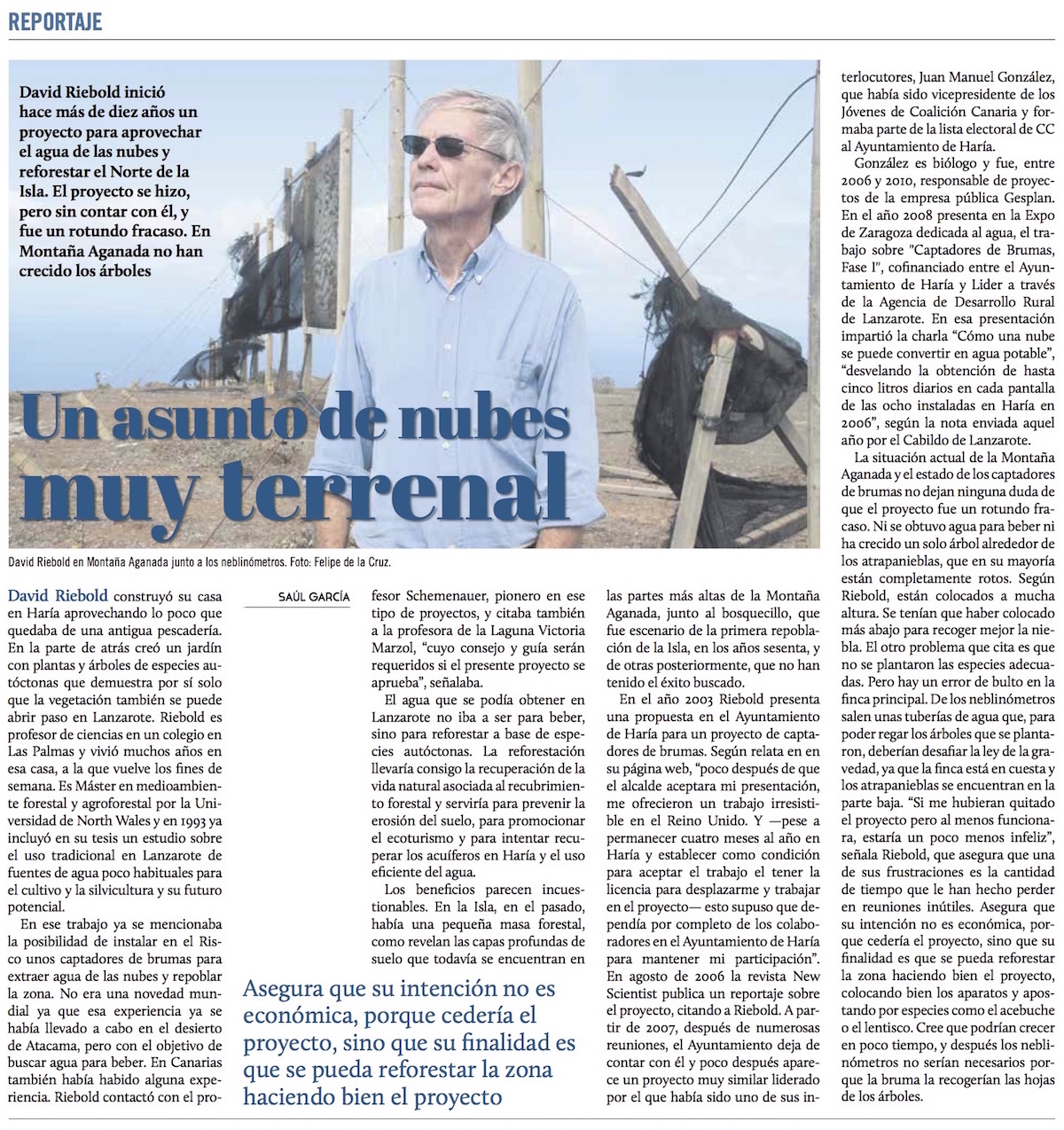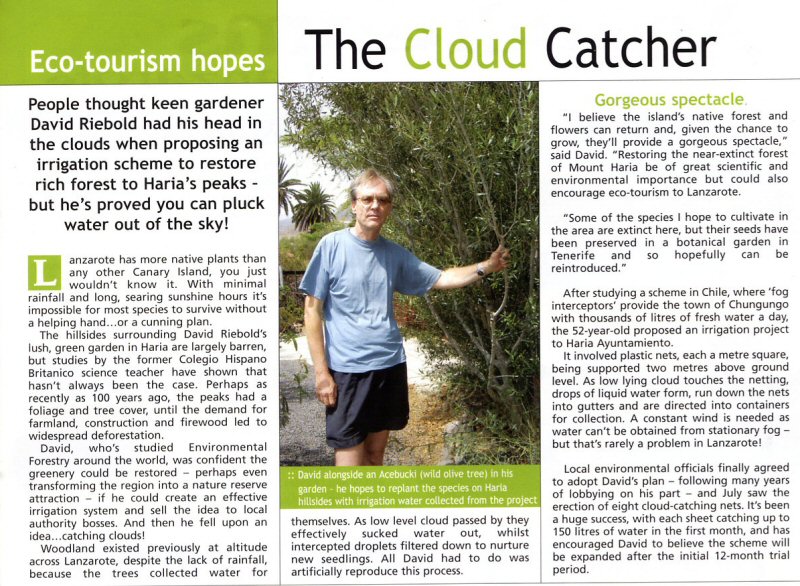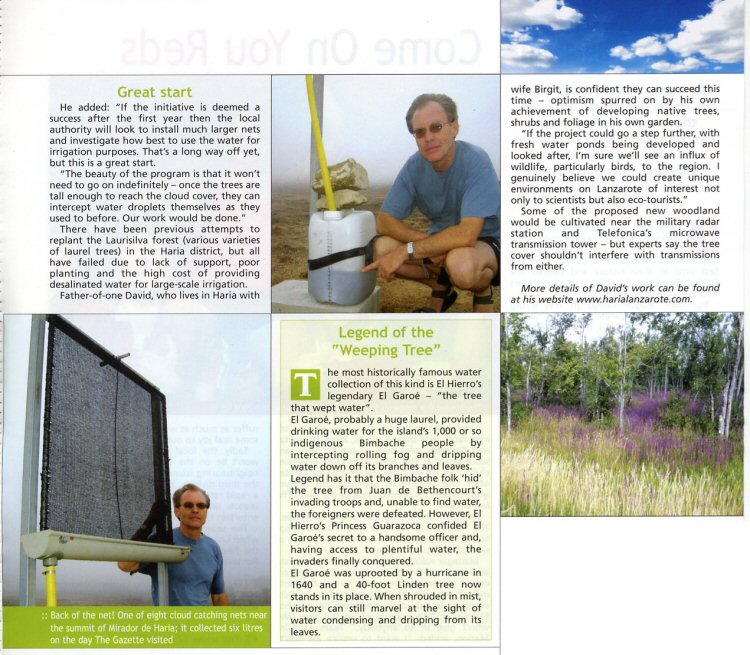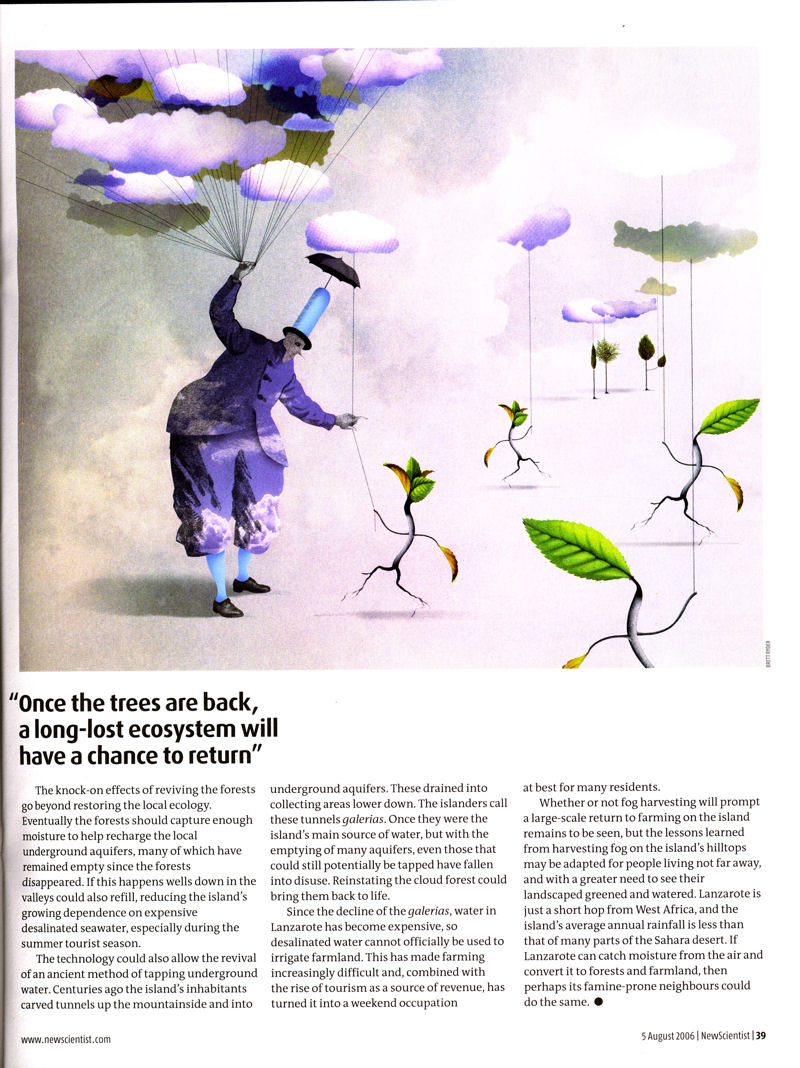CLOUD CATCHING
JUSTIFICATION AND CONTEXT
BIOSPHERE RESERVE
AIMS OF PROJECT
OBJECTIVES OF PROJECT
- Restoration of forest cover (and associated wildlife) to Mt. Haria.
- Prevention of soil erosion.
- Promotion of eco-tourism.
- Development of Lanzarote’s tradition of efficient use of water resources.
A MODERN RESPONSE THE WATER CRISIS
It is clear that the ‘water crisis’ is rapidly becoming as one of the great problems facing the world. Such shortages of fresh water require sustainable responses which may involve exploitation of hitherto neglected sources.
Here, as in much of the world, lack of water is the limiting factor for plant growth. Past attempts to reintroduce native flora to Mt. Haria have depended on irrigation in order for the plants become established. This has proved to be a key weakness as funding and co-ordination for this has been lacking. In any case evaporation of irrigation water in high temperatures may ultimately cause a build up of salt, which remains in the ground reducing soil fertility. In contrast to many other sources (especially desalinated water) water produced from fog interception contains very little impurity. In any case desalinated water is expensive and direct human needs have priority for its use – it is certainly not economically viable to use desalinated water for large-scale irrigation.
The Canaries have a tradition going back over thousands of years of making efficient use of their limited water resources. Most relevant to this case is the legendary ‘El Garoe’, the ‘arbol santo’ of El Hierro. A huge tree (probably a laurel), which intercepted rolling fog, the water dripping from its leaves and branches into cisterns providing drinking water for the inhabitants. The pine forests of Tenerife contribute more to stream water by fog capture than is provided by rainfall.
Recently, techniques for extracting water from this source have been refined by scientists and in the last decade several fog-collecting schemes have been initiated. The most well known of these is in the town of Chungungo in Chile providing thousands of litres of water every day from fogs intercepted at a nearby hilltop. Dr. Robert Schemenauer, the Canadian cloud physicist who has pioneered this work, has visited Lanzarote and believes the island to have definite potential for such a scheme. He points out that the Canaries have our own expert on fog collection in the person of Dra María Victoria Marzol Jaén of the University of La Laguna, Tenerife whose advice and guidance will be sought if the project is approved.
Dr. Schemenauer is executive director of FogQuest, an innovative, international, non-governmental, non-profit organisation, which implements and promotes environmentally appropriate use of fog collecting techniques. “FogQuest: sustainable water solutions” was incorporated in the Province of Ontario as a not-for-profit corporation according to Letters Patent # 1434908 on 15 September 2001. FogQuest has status as a registered charity with the Government of Canada. The expertise of FogQuest will be used to assess and guide this project.
DETAILED OBJECTIVES
REFORESTATION
It is important to be clear that, despite the small amount of rainfall Lanzarote experiences, parts of this island once enjoyed a cover of forest. Evidence that these trees were removed fairly recently is provided by the deep layers of soil still present on the very highest parts of the Montaña de Haria. Such depth of topsoil can only have resulted from millennia of forest cover. Before deforestation, fogwater was intercepted by the leaves and branches of mature trees and would drip onto the ground. Seedlings were thus nurtured from a water source that is no longer being intercepted.
As noted, previous attempts to restore tree cover to Montaña de Haria have met with limited success as the majority of treelings succumbed to the summer heat and aridity. Observation shows that most of the surviving trees are located in parts of the mountain where ground-level fog is common. Contact with this fog has clearly provided these trees with a source of water, which has been a crucial factor in their survival. In other areas the same fog exists a meter or two above the ground. Trees in such sites may need help surviving until they are tall enough to reach this moisture themselves. For a relatively small investment plastic nets can be used to intercept useful amounts of water from the frequent fogs that roll over the mountain. This water can provide a ‘kick-start’ to the re-establishment of the ‘laurisilva’ cloud forest that once existed.
PREVENTION OF SOIL EROSION
The valuable topsoil layer that remains is rapidly eroding. This is due not only to the loss of tree cover but also to the degradation of the stone-walled terraces; kicked over by ramblers and rabbit hunters. Various projects designed to halt soil erosion seem to have been initiated without any inclusion of tree planting. As it is the past removal of trees, which is largely responsible for this erosion, any attempt at control which does not include reforestation may prove to be, at best, short term.
PROMOTION OF ECO-TOURISM
The Biosphere Reserve status with which Lanzarote is honored with has yet to be fully exploited in terms of its tourist potential. Modern awareness of environmental problems is producing a new type of tourist who is as much interested in Lanzarote’s unique biology, geology and culture as in our sunshine and beaches. The increasing popularity of walking tours and visitors to the wind generators in Los Valles illustrate this, however wind farms already exist all over Europe and cannot be expected to create the same level of interest as a fog stripping project. Access to interested tourists therefore seems a desirable feature right from the start. A tree will be planted by each SFC, irrigated with collected water (after measurement), thus providing a demonstration of the projects potential. As the project develops decisions can be made about the extension of footpaths or roads.
Another possible future addition is the construction of a small pond as an adjunct to a storage tank. It is easy to demonstrate how the most modestly sized body of water on Lanzarote rapidly becomes a magnet for wildlife – frogs birds and butterflies are all the more fascinating and striking for being encountered in the dry landscape of this island.
DEVELOPMENT OF EFFICIENT WATER STRATEGIES
Scientific knowledge gained from this project may be of great significance elsewhere (e.g. the Cape Verde islands). As well as the recently developed technique of fog-collecting nets this project will make use of traditional local stone mulching practices i.e. a layer of ‘picon’ (lapilli) will be used to suppress evaporation around newly planted treelings.
LOCATION OF SITES
The shaded area on the enclosed map includes all sites considered as appropriate for assessment using Standard Fog Collectors (SFC’s). This area contains both the military radar station and Telefonica’s microwave transmission tower. Obviously both organizations should be consulted about this project but serious objections are not anticipated; during informal consultations a Telefonica engineer has stated that neither the fog collectors themselves nor the anticipated tree growth should cause any interference with these two operations as both plastic and wood are relatively transparent to the electromagnetic frequencies involved. It is to be hoped that these organizations will actively support this scheme as it may serve to beautify the rather denuded areas they use.
Consultation with individuals and organisations familiar with the area is essential – not only to gain support for the project but also to gather information to assist with selection of sites for the SFC’s.
DESCRIPTION OF METHODS
OVERVIEW
- Assessment – sites for standard fog collectors (description below) will be selected and the SFC’s installed, measurements will be collected from these over a period of one year, data will be evaluated by FogQuest and any suitable sites for large fog collectors identified;
- Large fog collectors will be installed in any sites so identified, whenever possible the SFC’s can be moved to enable investigation of other areas, treelings will be planted and appropriate systems to distribute collected water to them will be installed;
- Opportunities to expand the scheme to other parts of Mt. Haria will be investigated.
DETAILED SCHEDULE FOR PHASE 1
- Once confirmation of funding is obtained a schedule for the project will be finalized.
- An initial meeting will be held with people who may be affected by the project to inform them of the plans and ask for their input and participation.
- The standard fog collectors will be constructed;
- The executive director of FogQuest, from Canada will then travel to Lanzarote to meet with Mr. Riebold and potential partners in the project to choose the exact locations of the SFC’s and to do an initial assessment of the needs for a subsequent operational project;
- Measurements will be carried out for a minimum of 12 months – observation suggests that a bimodal distribution exists, with fog common during the hottest periods of summer as well as in wintertime. Data will be collected on a routine basis from the field sites and sent to Chile for review and analysis; the final data set will be examined at the FogQuest office in Toronto;
- The data from the SFC’s will be used to assess the amount of water that is available from fog and rainfall collection, the variability of the water production and the requirement for reservoirs;
- A brief preliminary report will be produced when 75% of the field data are available; this will be used to guide decisions as to whether an operational project is suitable in one or more areas;
- A final report will be produced when all the field data are available, verified and processed.
PHASES 2 and 3
These will only proceed if and when FogQuest’s analysis of the data gathered during Phase 1 indicates a high probability of success. The ultimate goal of this project is to recreate as closely as possible the forest ecosystem that once characterized Mt. Haria. This ambitious aim requires commitment from sponsoring agencies to allow treeling planting and construction of large fog collectors, pipelines, reservoirs and wildlife ponds.
TECHNICAL DETAILS
1.Construction of Standard Fog Collectors.
A standard fog collector consists of a 1m x 1m frame raised 2m above ground level which supports a double layer of (locally available) polypropylene plastic mesh netting. As fog touches the netting drops of liquid water form, which run down the nets into gutters that direct it into suitable containers. The budget (below) assumes that these can be constructed locally – if this proves impractical FogQuest can provide these at additional cost. Sites which are identified as suitable by these standardised collectors can be subsequently fitted with larger more permanent collectors, the precise shape and size of which will depend on the topology of the site – in El Tofo, Chile collectors with a span between posts of 12m have proved practical.
2.Identification of suitable site
This is an aspect of the project where involvement of local people is essential. Anyone who lives or farms in this area will obviously be an invaluable source of information. Several factors must be taken into consideration:
- Frequent presence of low-level fog.
- A constant wind. It is important that the fog is not stationary.
- Absence of any rare or otherwise important flora which might be damaged.
- Conformity to decisions about the visibility of the collectors.
- Sufficient accessibility and stability to permit construction work.
- Visible soil erosion. A tree planted in or near a gully will not only help to prevent further erosion but will also benefit from the excess ground water that created the gully in the first place.
3.Selection of tree species
In general it is felt that local species are always preferable to exotics. A species of tree that has existed here for millennia will inevitably support a far greater range of local fauna than a recent import. As well as providing food and habitat for familiar animal life the importance of associated soil fungi and bacteria is becoming increasingly recognized by scientists. A single type of tree may uniquely support dozens of species of microorganism in its rhizosphere (the region around its roots). In terms of human needs the loss of these may be even more important than the extinction of the species of tree itself. As antibiotic resistance becomes common new medicines are urgently required. Most antibiotics are based on fungal extracts, extinction of tree species means that fungal species are being lost before their potential use can be investigated. Exactly which species are used will inevitably depend on availability; seed sources from Lanzarote rather than other islands are preferred. Although the Canarian Pine (Pinus Canariensis) has clearly proved suitable for use in this area, a monoculture of this species would not represent a re-creation of this island’s unique but near extinct forest. Since this species is already well represented on Mt. Haria further plantings seem of low priority while a variety of other local species remain underrepresented.
about the author
David Riebold (BA, MSc, MEd) has lived in Haria (Calle la Cañada 2) for over a decade working as senior science teacher at a local secondary school. His Masters degree in Environmental Forestry/Agroforestry (University of North Wales) involved a study of Lanzarote’s traditional and potential future use of unusual sources of water for cultivation and forestry. The once-derelict land behind his house has been the site of much experimentation in tree planting, especially of local species and has developed into a unique wildlife garden.
references
ELFIN CLOUD FORESTS
One man's dream or how a scientific project became a political football
They sound like something from the Lord of the Rings but these delicate ecosystems are very real and nearer than you might think. Cloud forests exist where rolling cloud passes over hilltops and, although little or no rain is deposited the tiny water droplets which form the cloud are intercepted by leaves and branches of the trees and drip down into the soil, watering roots. In Tenerife, the pine forest, by intercepting cloud in this way, provides several times more ground water than the island gets from rainfall. The magnificent Tenerife forest is certainly not elfin, it forms a ring which does not reach the peak of Mt. Teide and is consequently protected from the worst of the wind. Elfin forests exist on hilltops and lack this protection, therefore trees tend to be stunted and bent by constant gales. Such a forest existed on the highest parts Haria district until a century or two ago, now only a handful of trees remain but the thickness of topsoil proves without doubt that such a forest existed there until fairly recently. There were no pines as these are not native to Lanzarote, but instead trees such as the Acebuche, a relative of the cultivated olive, formed a forest ecosystem known as Laurisilva . Despite its aridity Lanzarote may have more unique plants than any other Canary island, most of which are native to this region, if trees could be re-established other native flora and fauna can be expected to follow, an ecosystem of great biological importance would be resurrected. A splendid goal in a century becoming increasingly characterised by wholesale destruction of such delicate ecosystems!
If you take a walk along Haria’s Mt. Aganada when cloud cover is present (take care not to get lost!) you will notice that the cloud hovers a metre or so above the ground – your hair gets damp while your legs remain dry. This illustrates the problem that reforestation schemes have so far met, until a tree grows big enough it cannot access water from passing clouds. Young trees have been planted in their thousands, most have dried up and died.
Now a simple but effective method of nurturing treelings is being implemented. Some large nets supported high above the ground, have been positioned so as to intercept passing clouds, liberating hundreds of litres of pure water used to feed tree roots until they grow tall enough to take over from the nets, effectively kick-starting development of a new forest.
I love trees and have spent much of the last 20 years cultivating some of our rare native flora in my garden, I am therefore very interested to see that the Mayor of Haria and his political associate Juan Manuel Gonzalez have not only implemented this project but have also presented it to the Biosphere department on the 11th of August when it won an award for sustainable projects.
Just one little problem bothers me, how is this work, presented as his own by Snr. Gonzalez, any different from the proposal I wrote up on the request of the Mayor and shown to him in 2003? My original proposal has been available since then for all to see on my website, harialanzarote.com . At first the years of work I put into the scheme were acknowledged , newspaper reports called the pilot scheme ‘Projecto David’. But when I started to talk about sources of funding for phase 2 of the project Snr. Gonzalez became very cagy, refusing to give me any access to his accounts claiming that I had no right to ask about finances for the scheme because ‘it had nothing to do with me’ in fact, he said, I had merely plagiarised the work from another scientist. If you look at the proposal on my website you can see that I mention a Canarian Scientist, Professora Marzol, as a possible source of collaboration, indeed I had been in communication with her many years before as she has experience with cloud interception as a source of drinking water. She tells me she is most surprised to be used as an excuse for removing the project from my involvement. If my work was in fact stolen from her it would seem most unlikely that I would name her in my proposal!
Mine was the first proposal to use cloud catching techniques to restore the Haria cloud forest. In fact, the thesis outlining the project which I prepared for my MSc degree in environmental forestry, available from the library of the University of North Wales (or from me!). seems to be the first suggest that the then recently developed cloud capture nets could be used for reforestation rather than just drinking water. My thesis written and accepted in 1993, many years before I persuaded the mayor that my project was feasible and he asked me to prepare the project proposal.
For a long time the mayor continued to give me false assurances, when I asked him to confirm that the years of scientific study I had put into the project would not be wasted, but it became clear that the suggestion that I had stolen the project from Prof. Marzol was being circulated among councillors, so I prepared a copy of some documents proving my original authorship and left copies at the ayuntamiento for every member of the council. The mayor prevented these from being passed on and at the same time stopped pretending to have any sympathy for my situation.
Shortly after this disappointment a chain of officials started turning up at my house saying that I had ‘stolen’ a couple of metres of baranco when I repaired a wall and had to pay thousands of euros to put things right. The whole case was ridiculous and was eventually thrown out of court, but not before costing me a lot of time and worry. Of course it is probably ridiculous to suspect that this problem was a warning to me from the mayor not to rock the boat for his friend. But when I contrast the enormous trouble about that wall with the apparent total absence of action over entire buildings that are illegally springing up like mushrooms all over Haria, I can’t help but wonder if the mayor isn’t capable of using his power to both punish and reward.
Since the mayor now refuses to see me and JM has broken his promise to keep me informed of developments I would like to present the following open letter to them both;
JM you have shamelessly stolen my project, pretending expertise you lack. You have added insult to injury by suggesting that it is was not my original idea in the first place. If you say that ‘your’ project involves doing anything significant other than following the instructions as written in my original proposal then you are a liar.
Snr Mayor, I trusted you with my project as a collaboration. You have taken it without my permission using it to reward your political associate, a one time insurance salesman who had never grown a tree in his life. If you gain control of the Cueva and Jameos as you intend, will it be to the advantage of those who have worked selflessly for the benefit of Haria district it or only your fellow members of the Coalicion Canarias? It is ironic that you launched your career as mayor with a vitriolic attack criticising the lack of honesty of Snr. Ramirez, the previous mayor (now ‘rehabilitated’ as a fellow member of the Coalition Canarias). Whatever Ramirez was guilty of, it probably only involved money – you however have stolen years of my life.
Location
C. la Cañada, 2, 35542 Haría, Las Palmas
Contact us
David (+34) 654 852 479 david.riebold@gmail.com






